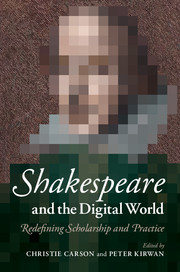Book contents
- Frontmatter
- Contents
- Notes on contributors
- Acknowledgements
- Shakespeare and the digital world
- Part I Defining current digital scholarship and practice
- Part II Defining current digital scholarship and practice
- Half-time: A pause for reflection
- Part III Redefining the boundaries and practices of Shakespeare studies online
- Part IV Redefining the boundaries and practices of Shakespeare studies online
- 14 Changing a culture with the Shakespeare Birthplace Trust
- 15 Developing a digital strategy
- 16 The impact of new forms of public performance
- 17 Creating a critical model for the twenty-first century
- Conclusion
- Index
- References
16 - The impact of new forms of public performance
Published online by Cambridge University Press: 05 July 2014
- Frontmatter
- Contents
- Notes on contributors
- Acknowledgements
- Shakespeare and the digital world
- Part I Defining current digital scholarship and practice
- Part II Defining current digital scholarship and practice
- Half-time: A pause for reflection
- Part III Redefining the boundaries and practices of Shakespeare studies online
- Part IV Redefining the boundaries and practices of Shakespeare studies online
- 14 Changing a culture with the Shakespeare Birthplace Trust
- 15 Developing a digital strategy
- 16 The impact of new forms of public performance
- 17 Creating a critical model for the twenty-first century
- Conclusion
- Index
- References
Summary
Being there: Presence, absence, liveness
We zoom in on an extreme close-up of a high-definition camera lens, which morphs into a computer-generated image of a circular auditorium, before the screen resolves into the logo of the media company Digital Theatre. Digital Theatre sells online and downloadable video recordings of live theatre performances (including, of course, several high-profile Shakespearean productions). Its trailers all begin with the same animated logo, which is designed, presumably, to convey the fluidity with which its productions traverse the digital and the theatrical domains. Its trailers all end in the same way, too, with the paradoxical catchphrase: ‘Digital Theatre. Be there.’ One would assume, of course, that the main reason for purchasing one of Digital Theatre’s products is that one could not ‘be there’; customers might have missed the original production, for example, or simply desire a lasting record of a cherished theatrical experience which has now passed into memory. The catchphrase tantalises its online audience with the impossible: you are not ‘there’, it seems to be saying, but this product can make you feel as though you were.
This simultaneous privileging and troubling of physical presence as a signifier of theatrical authenticity is something that underlies much of the performance work considered in this chapter. Writing in 1999, Philip Auslander famously challenged the ‘reductive binary opposition of the live and the mediatized’ (2008: 3) which he had identified in the work of critics such as Peggy Phelan. For Phelan, the distinction was precise:
Performance’s only life is in the present. Performance cannot be saved, recorded, documented, or otherwise participate in the circulation of representations of representations: once it does so it becomes something other than performance.
(1993: 146)- Type
- Chapter
- Information
- Shakespeare and the Digital WorldRedefining Scholarship and Practice, pp. 212 - 225Publisher: Cambridge University PressPrint publication year: 2014
References
- 3
- Cited by



